Crucial v4 (256GB) Review
by Kristian Vättö on November 22, 2012 1:01 PM ESTAnandTech Storage Bench 2011
Last year we introduced our AnandTech Storage Bench, a suite of benchmarks that took traces of real OS/application usage and played them back in a repeatable manner. Anand assembled the traces out of frustration with the majority of what we have today in terms of SSD benchmarks.
Although the AnandTech Storage Bench tests did a good job of characterizing SSD performance, they weren't stressful enough. All of the tests performed less than 10GB of reads/writes and typically involved only 4GB of writes specifically. That's not even enough exceed the spare area on most SSDs. Most canned SSD benchmarks don't even come close to writing a single gigabyte of data, but that doesn't mean that simply writing 4GB is acceptable.
Originally we kept the benchmarks short enough that they wouldn't be a burden to run (~30 minutes) but long enough that they were representative of what a power user might do with their system. Later, however, we created what we refer to as the Mother of All SSD Benchmarks (MOASB). Rather than only writing 4GB of data to the drive, this benchmark writes 106.32GB. This represents the load you'd put on a drive after nearly two weeks of constant usage. And it takes a long time to run.
1) The MOASB, officially called AnandTech Storage Bench 2011—Heavy Workload, mainly focuses on the times when your I/O activity is the highest. There is a lot of downloading and application installing that happens during the course of this test. Our thinking was that it's during application installs, file copies, downloading, and multitasking with all of this that you can really notice performance differences between drives.
2) We tried to cover as many bases as possible with the software incorporated into this test. There's a lot of photo editing in Photoshop, HTML editing in Dreamweaver, web browsing, game playing/level loading (Starcraft II and WoW are both a part of the test), as well as general use stuff (application installing, virus scanning). We included a large amount of email downloading, document creation, and editing as well. To top it all off we even use Visual Studio 2008 to build Chromium during the test.
The test has 2,168,893 read operations and 1,783,447 write operations. The IO breakdown is as follows:
| AnandTech Storage Bench 2011—Heavy Workload IO Breakdown | ||||
| IO Size | % of Total | |||
| 4KB | 28% | |||
| 16KB | 10% | |||
| 32KB | 10% | |||
| 64KB | 4% | |||
Only 42% of all operations are sequential; the rest ranges from pseudo to fully random (with most falling in the pseudo-random category). Average queue depth is 4.625 IOs, with 59% of operations taking place in an IO queue of 1.
Many of you have asked for a better way to really characterize performance. Simply looking at IOPS doesn't really say much. As a result we're going to be presenting Storage Bench 2011 data in a slightly different way. We'll have performance represented as Average MB/s, with higher numbers being better. At the same time we'll be reporting how long the SSD was busy while running this test. These disk busy graphs will show you exactly how much time was shaved off by using a faster drive vs. a slower one during the course of this test. Finally, we will also break out performance into reads, writes, and combined. The reason we do this is to help balance out the fact that this test is unusually write intensive, which can often hide the benefits of a drive with good read performance.
There's also a new light workload for 2011. This is a far more reasonable, typical every day use case benchmark. It has lots of web browsing, photo editing (but with a greater focus on photo consumption), video playback, as well as some application installs and gaming. This test isn't nearly as write intensive as the MOASB but it's still multiple times more write intensive than what we were running last year.
We don't believe that these two benchmarks alone are enough to characterize the performance of a drive, but hopefully along with the rest of our tests they will help provide a better idea. The testbed for Storage Bench 2011 has changed as well. We're now using a Sandy Bridge platform with full 6Gbps support for these tests.
AnandTech Storage Bench 2011—Heavy Workload
We'll start out by looking at average data rate throughout our new heavy workload test:
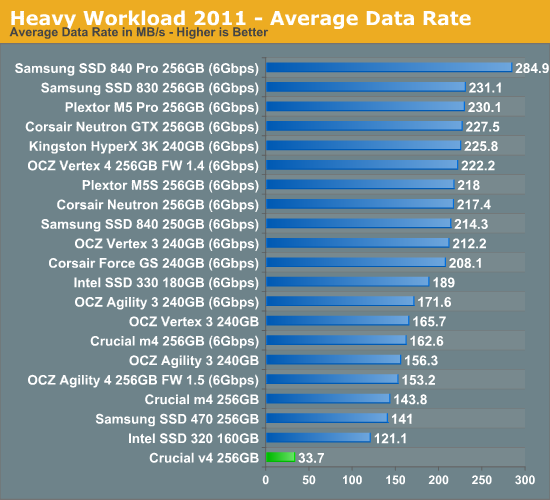
The poor random read/write speeds do have a significant impact on our Storage Suite scores as well. The v4 is the slowest SSD we have tested since the creation of the MOASB. To put this in perspective, it took over six hours for the Heavy suite to run, whereas it usually takes around an hour and a half. Any current SSD will be three to five times faster than the v4, even when operating at SATA 3Gbps speeds.
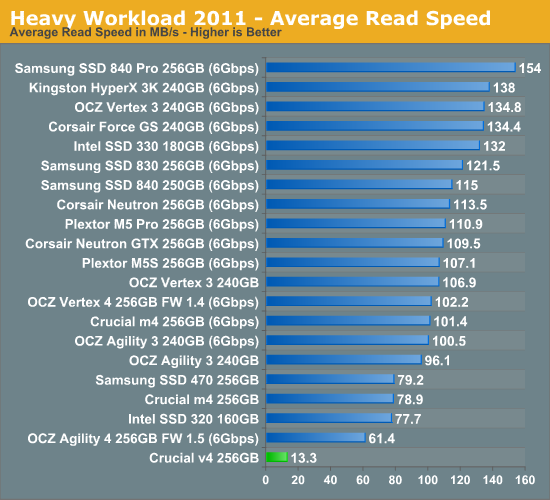
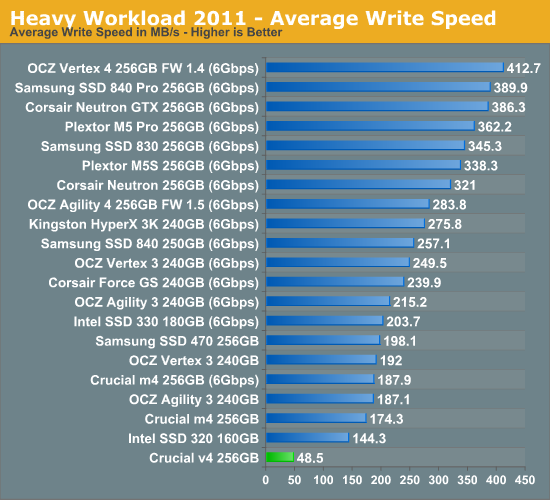
The next three charts just represent the same data, but in a different manner. Instead of looking at average data rate, we're looking at how long the disk was busy for during this entire test. Note that disk busy time excludes any and all idles; this is just how long the SSD was busy doing something:

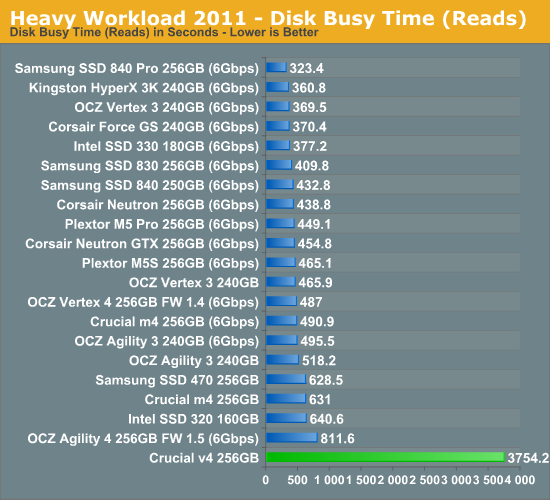
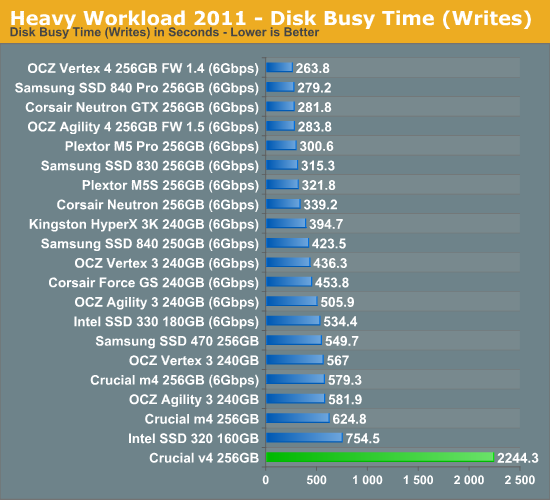










44 Comments
View All Comments
mattdobs - Thursday, November 22, 2012 - link
Sounds like Crucial needs to buy OCZ's Indilinx controller to make a wining drive.extide - Friday, November 23, 2012 - link
Uhhhh.... I don't think you get the point of this drive.... And they should definitely not buy an OCZ controller.Beenthere - Thursday, November 22, 2012 - link
Almost no one could ever actually tell the performance difference between any SATA 2 vs. any SATA 3 SSD in actual use, unless you run the benches - which may be inaccurate as we see with compressible data and SandForce controllers. I suspect SSD makers have also learned how to inflate the numbers just as GPU makes have.That being said there is a price point at which people will buy anything they perceive is of value. ~$100 for an ~128 GB. SSD is enough for many people to buy. Quite frankly only a small percentage of consumers acuti\ully need a large capacity SSD/HDD. Most folks can get buy with 60-128 GB. capacity but naive consumers have been programmed to believe they need a 500 GB. drive. Few people do but when you can buy a 500 GB. HDD for $100 many people take the bait.
yyrkoon - Thursday, November 22, 2012 - link
"Few people do but when you can buy a 500 GB. HDD for $100 many people take the bait."How do you know what people need ? You don't.
At any rate. I'd say many people who feel they need a SSD for $100 are swallowing the bait. hook, line and sinker. Until prices drop significantly. There are many reasons why to opt for more storage versus performance. Very few productive applications take advantage of that much disk performance. Unless you will propose that running multiple SSD's in one large RAID array to play the latest greatest game is something most consumers do . . . Or sit and stare at how fast windows boots.
See, most people have a life that does not revolve around computers. Novel idea I know. Then when they do use a computer, they generally do not care if it takes a few extra seconds to load something from disk. But they *do* care if the disk they use wont hold their family pictures, videos, or audio collection.
Also, you can buy a good 1TB 2.5" HDD for less than $100 now days . . .
Chaser - Thursday, November 22, 2012 - link
Anandtech consistently recommends not filling a SSD to capacity and leaving a portion of it unused for performance purposes. So for me I go with a 240GB SSD so that I don't have to "swap out" games. Yes I want higher performance in gaming with zone/instance loading etc.I ALSO use a 500GB magnetic drive as my media drive for docs, pics, music, data in general.
So this is what I NEED and enjoy using.
Zanegray - Friday, November 23, 2012 - link
"Very few productive applications take advantage of that much disk performance. Unless you will propose that running multiple SSD's in one large RAID array to play the latest greatest game is something most consumers do . . . Or sit and stare at how fast windows boots."Honest question, have you used an ssd before? Because your post sounds like you've never touched one. Boot times are not the reason I run an ssd. I run an ssd because nearly every application benefits - from app start up to saving a file to browsing the file system to caches (you must use an Internet browser). SSD's are the new client side storage paradigm and until you realize that you are stuck in the past.
Beenthere - Friday, November 23, 2012 - link
SSDs are an "immature technology" as Anand has stated. While they can offer improved performance over a HDD, they still have teething issues in many cases. Until all of the Bugs are resolved, a lot of people will wait to upgrade as the hassles aren't worth the modest performance gain, based on my testing.extide - Friday, November 23, 2012 - link
Sadly, you are doing it wrong if you are only getting a moderate performance increase. Terribly wrong :/hp79 - Sunday, November 25, 2012 - link
I only have one comment for you. You must be stuck in 2007.erple2 - Sunday, November 25, 2012 - link
I think that you're right. The average consumer doesn't want the hassle of trying to remember where they put thing on which drive, plus have to manage the hassle of 2 drives. So until these are cheap at about 500 gigs (~$200), were stuck with the false promise of 120 gig ssd's.I have a laptop with a 160gig ssd plus a 250gig spindle drive, and I gave up on the general hassle of remembering what goes where and where I put things. I had to go to the internet to figure out "esoteric" windows CLI utilities to move my user profile to the magnetic drive (how freaking hard, Redmond, is it to mimic 'ln -s source destination'?????? Why are files treated any different than directories?????). And I'd consider myself a much more patient (and advanced) user than ordinary consumers. I now just do the uninstall/reinstall swap instead.
I suppose that I mostly blame steam, but that's not fair for the finger pointing share.